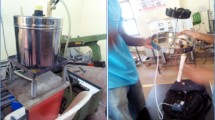Abstract
Pollution by pathogenic bacteria was examined in 150 French metalworking fluid samples. Gram-negative micro-organisms such asSalmonella spp.,Shigella spp., andVibrio spp. as well as Gram-positive cocci were never isolated. Nevertheless opportunistic pathogens such asPseudomonas aeruginosa andKlebsiella pneumoniae still contaminated these fluids with an isolation frequency of 17% of samples for each. These two micro-organisms failed to grow or even survive in vitro in sterile cutting fluids protected by biocides. Preliminary growth of other micro-organisms such asPseudomonas putida orPseudomonas fluorescens, which are the major part of the indigenous microflora, seemed to be a prerequisite for their growth. These former twoPseudomonas could resist three different classes of biocides and, at least in the case of formaldehyde-releasers, adaptation was followed by biocide deterioration. Resistance magnification was observed in the presence of the three different types of biocides and, in the case of formaldehyde releasers the resistance and deterioration levels were close to those recommended by the manufacturers. This is probably the reason why the preliminary growthof Pseudomonas putida allowed in vitro differed growth ofKlebsiella pneumoniae andPseudomonas aeruginosa. Due to relatively high isolation frequencies of opportunistic pathogens (17% of samples) periodical microbiological examination of cutting fluids should be carried out in order to evaluate risks for human health. Wearing masks and gloves is still recom-mended, at least in France.
Similar content being viewed by others
References
Cosmacini E, Monduzzi V. Inquinamento batterico degli ambienti di lavoro ad opera dei libro refrigeranti. Tribologia e Lubrificazione 1980; 15: 1–5.
Tant CO, Bennett EO. The isolation of pathogenic bacteria from used emusion oils. Appl Microbiol 1956; 4: 332–338.
Tant CO, Bennett EO. The growth of aerobic bacteria in metalworking fluids. Appl Microbiol 1958; 6: 388–391.
Sondossi M, Rossmoore HW, Wireman JW. Observation of resistance and cross resistance to formaldehyde condensate biocide inPseudomonas aeruginosa. International Biodeterioration 1985; 21: 105–106.
Marchal N, Bourdon JL, Richard C. Les milieux de culture pour l'identification biochimique des bactéries. Paris: Doin Éditeur, 1982.
Palleroni NJ. Genus I Pseudomonas. In: Holt JG (ed), Bergey's manual of determinative bacteriology, 9th ed. Baltimore: Willians & Wilkins, 1984.
Residual biocide test for soluble cutting-oil emulsions. Technical Bulletin from the British Petroleum Corporation, Technical Services Branch, TS/51/80/U.
Rossmoore HW, Rossmoore LA. The identification of a defined inoculum for the evaluation of biocides in water-based metalworking fluids. J Am Soc Lub Eng 1980; 36: 16–20.
Creach O. Action des tensioactifs naturels et de synthèse en bactériologie et en mycologie. Revue du Corps de Santé des Arm ées 1968; 9 (1): 61–88.
Bennett EO, Wheeler HO. Survival of bacteria in cutting fluids. Prog Ind Microbiol 1954; 2: 368–371.
Bennett EO. Factors involved in the preservation of metal cutting fluids. Dev Indust Microbiol 1961; 3: 273–285.
Bennett EO. Formaldehyde preservatives for cutting fluids. Int Biodet Bull 1973; 9 (4): 95–100.
Onyekwelu IU, Bennett EO, Gannon JE. The effective life of preservatives in cutting fluids concentrates. Tribology, 7–9 February 1981.
Rossmoore HW, Demare J, Smith THG. Anti and promicrobial activity of hexahydro 1, 3, 5 tris (2-hydroxyethyl)-s-triazine in cutting fluid emulsions. Biodeterioration of Materials, Vol. 2: 286–293. New York: Halsted Press, 1972.
Krzeminski SF, Brackett CK, Fisher JD. Fate of microbicidal 3-isothiazolone compounds in the environment: Modes and rates of dissipation. J Agric Food Chem 1975; 23: 1060–1068.
Lewis S, Miller GA, Low AB. (to Rohm and Haas Company). US Patent 3,761,488 (25 September 1973).
Costerton JW, Lashen ES. Influence of biofilm on efficacy of biocides on corrosion-causing bacteria. Material Performances, 13–17 February 1984.
Collier PJ, Ramsey AJ, Austin P, Gilbert P. Growth inhibitory and biocidal activity of some isothiazolone biocides. J Appl Bacteriol 1990; 69: 569–577.
Collier PJ, Ramsey A, Waight RD, Douglas KT, Austin P. Chemical reactivity of some isothiazolone biocides. J Appl Bacteriol 1990; 69: 578–584.
Collier PJ, Austin P, Gilbert P. Isothiazolone biocides: enzymes-inhibiting pro-drugs. Int J Pharmaceutics 1991; 74: 195–201.
Lewis S, Miller GA. Derivation of 3-isothiazolone with active halogen compounds. US Patent 3,835,150 (1974).
Voets JP, Pipyn P, Van Lancker P, Verstaete W. Degradation of microbicides under different environ-mental conditions. J Appl Bact 1976; 40: 67–72.
Bennett EO. The biodeterioration of metal cutting fluids. Prog Ind Microbiol 1974; 16: 123–149.
Author information
Authors and Affiliations
Rights and permissions
About this article
Cite this article
Chazal, P.M. Pollution of modern metalworking fluids containing biocides by pathogenic bacteria in France. Eur J Epidemiol 11, 1–7 (1995). https://doi.org/10.1007/BF01719939
Accepted:
Issue Date:
DOI: https://doi.org/10.1007/BF01719939




